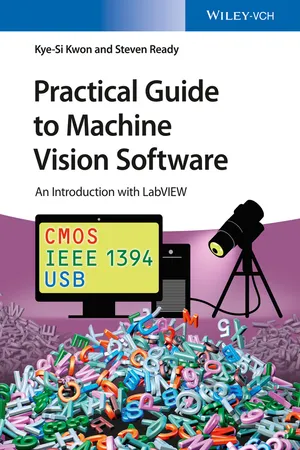
Practical Guide to Machine Vision Software
An Introduction with LabVIEW
- English
- ePUB (mobile friendly)
- Available on iOS & Android
About This Book
For both students and engineers in R&D, this book explains machine vision in a concise, hands-on way, using the Vision Development Module of the LabView software by National Instruments.
Following a short introduction to the basics of machine vision and the technical procedures of image acquisition, the book goes on to guide readers in the use of the various software functions of LabView's machine vision module. It covers typical machine vision tasks, including particle analysis, edge detection, pattern and shape matching, dimension measurements as well as optical character recognition, enabling readers to quickly and efficiently use these functions for their own machine vision applications. A discussion of the concepts involved in programming the Vision Development Module rounds off the book, while example problems and exercises are included for training purposes as well as to further explain the concept of machine vision.
With its step-by-step guide and clear structure, this is an essential reference for beginners and experienced researchers alike.
Frequently asked questions
Information
1
Basics of Machine Vision
1.1 Digital Images
1.1.1 Grayscale Image

1.1.2 Binary Image
Table of contents
- Cover
- Related Titles
- Title Page
- Copyright
- About the Authors
- Preface
- Chapter 1: Basics of Machine Vision
- Chapter 2: Image Acquisition with LabVIEW
- Chapter 3: Particle Analysis
- Chapter 4: Edge Detection
- Chapter 5: Pattern Matching
- Chapter 6: Color Pattern Matching
- Chapter 7: Dimension Measurement
- Chapter 8: Dimension Measurement Using Coordinate System
- Chapter 9: Geometric Matching
- Chapter 10: Binary Shape Matching
- Chapter 11: OCR (Optical Character Recognition)
- Chapter 12: Binary Particle Classification
- Chapter 13: Contour Analysis
- Chapter 14: Image Calibration and Correction
- Chapter 15: Saving and Reading Images
- Chapter 16: AVI File Write and Read
- Chapter 17: Tracking
- Chapter 18: LabVIEW Machine Vision Applications*
- Chapter 19: Student Projects
- Index
- EULA